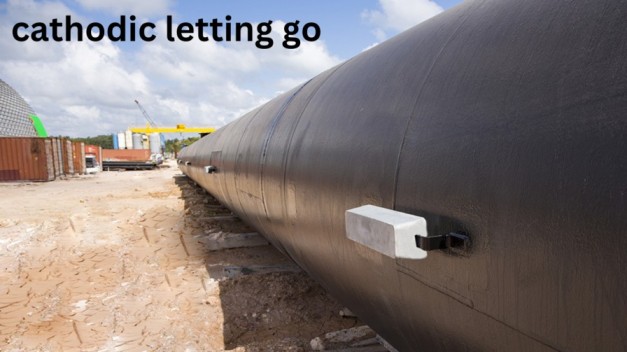Introduction
Hey there! If you’ve ever worked with metal structures like pipelines, storage tanks, or even marine vessels then you’re probably aware of how damaging corrosion can be. But did you know there’s a protective system in place to prevent that damage? It’s called cathodic protection. In this blog post, we’re going to talk about a phenomenon known as “cathodic letting go,” which happens when that protective system fails. Don’t worry we’ll break it all down, so you’ll understand what it is, why it happens, and how to prevent it. Let’s dive in!
Overview of Cathodic Letting Go
What is Cathodic Protection?
Cathodic protection is a method used to prevent corrosion on metal surfaces. It works by turning the metal into a cathode (the negative electrode) in an electrochemical reaction. To make it work, a power supply is used to introduce a flow of electrons, which shifts the metal’s electrical potential to a more negative value. When done right, this makes it much harder for corrosion to happen.
But sometimes, the system doesn’t work like it’s supposed to. That’s when we talk about “cathodic letting go,” which is when the system fails, and corrosion starts to rear its ugly head again. Not good!
Definition and Purpose
In simple terms, cathodic protection is like giving metal a protective shield to stop it from rusting or corroding. The purpose is to keep expensive infrastructure in good condition and prevent failure. However, if cathodic protection fails due to a process like cathodic letting go, corrosion can set in quickly.
The Mechanism of Action
So, how does cathodic protection actually work? The process starts by setting up a direct current (DC) power supply. This power supply creates a flow of electrons to the metal structure (like a pipeline), which turns the structure into the cathode. On the other side of the system, we have an anode that is deliberately allowed to corrode instead, providing the necessary electrons to stop the metal from corroding. As long as the anode is working and the power supply is steady, the structure remains protected.
Now, if something goes wrong like with the power supply or anode depletion it can lead to cathodic letting go. When this happens, the protection fails, and the metal structure becomes vulnerable to corrosion.
You May Also Read: Boost Your Learning with thestudypoints in Today
Causes of Cathodic Letting Go
There are a few different things that can cause cathodic protection to fail, leading to cathodic letting go. Let’s go through them.
Power Supply Issues
The most obvious reason for failure is a problem with the power supply. If there’s an issue, such as a loss of current, the metal structure won’t stay polarized, and corrosion can start. It’s like a car running out of gas—without the current, the cathodic protection can’t do its job, resulting in cathodic letting go.
Anode Depletion
The anodes used in cathodic protection don’t last forever. Over time, they can degrade or become depleted. When this happens, they stop being able to supply enough electrons to keep the metal structure protected. It’s like running out of energy once that happens, cathodic letting go occurs, and the metal is left vulnerable.
Environmental Changes
The environment surrounding the metal structure can have a huge impact on the effectiveness of cathodic protection. Things like changes in soil composition, moisture levels, and even temperature can affect the conductivity of the electrolyte, which in turn impacts the protection system’s performance. This is one of the reasons cathodic letting go can happen unexpectedly.
Equipment Malfunction
Sometimes, the issue is with the equipment itself. Faulty wiring, damaged components, or broken sensors can mess with the flow of current, causing the system to lose its protective capabilities. When this happens, cathodic letting go occurs, and corrosion takes over.
Consequences of Cathodic Letting Go
When cathodic protection fails, the results can be pretty bad. Let’s take a look at some of the key consequences of cathodic letting go.
Increased Corrosion Rates
This is the most obvious consequence: without the protection, corrosion speeds up. Metals begin to break down, leading to weakened infrastructure. Over time, this can result in leaks, cracks, and other forms of damage that require costly repairs. The failure of cathodic protection can cause an accelerated rate of corrosion, further contributing to cathodic letting go.
Safety Hazards
In industries like oil and gas, pipelines, and marine, when corrosion sets in, it’s more than just a financial issue. It’s a safety risk. Corrosion can lead to leaks, ruptures, or even explosions. This not only endangers the structure itself but also the people working around it. The process of cathodic letting go can turn a safe system into a dangerous one, with serious consequences.
Economic Impact
The financial cost of dealing with corrosion after cathodic protection fails can be massive. From repairing or replacing corroded structures to potential fines or legal costs if something goes wrong, the price of not maintaining the system can escalate quickly. The economic impact of cathodic letting go is something no industry wants to face.
Preventive Measures
Now, the good news is that there are ways to avoid all of this. With regular maintenance and a bit of foresight, you can prevent cathodic letting go from happening in the first place.
Routine Inspections
The key to keeping your cathodic protection system in top shape is regular inspections. Make sure you’re checking the system frequently to ensure it’s operating properly. This means checking the power supply, testing the voltage, and verifying that the anodes are still functioning. Regular monitoring can catch problems before they get too serious, preventing issues like cathodic letting go.
Anode Replacement
As we mentioned earlier, anodes don’t last forever. That means you’ll need to replace them at regular intervals to keep things running smoothly. By staying on top of anode replacement, you can avoid the depletion that leads to cathodic letting go.
Environmental Assessments
Since the environment plays a big role in the effectiveness of cathodic protection, it’s important to monitor it. Changes in soil or moisture levels could affect the system, so periodic environmental assessments can help you stay ahead of any potential issues. This can help reduce the risk of cathodic letting go due to environmental factors.
Conclusion
Summary of Importance and Maintenance Strategies
Cathodic protection is a lifesaver for metal structures, keeping corrosion at bay and ensuring long-term safety and reliability. But when it fails due to cathodic letting go, the consequences can be severe. From accelerated corrosion to safety hazards and economic impacts, it’s crucial to understand what can go wrong and how to prevent it. Regular inspections, anode replacements, and environmental assessments are key to keeping your cathodic protection system in working order.
FAQs
1. What is cathodic letting go?
Answer: Cathodic letting go refers to the failure or disengagement of a cathodic protection system, which is designed to prevent corrosion on metal structures. When this system fails, corrosion can resume, leading to potential damage and safety risks in infrastructures like pipelines, storage tanks, and marine applications.
2. What causes cathodic letting go?
Answer: Several factors can cause cathodic letting go, including power supply issues, anode depletion, environmental changes, and equipment malfunctions. Any disruption to the flow of current or a degradation in the system’s components can result in the failure of cathodic protection, allowing corrosion to take hold.
3. What are the consequences of cathodic letting go?
Answer: When cathodic protection fails, the consequences can be severe. These include increased corrosion rates, which weaken metal structures, safety hazards such as leaks or ruptures, and significant economic impacts due to costly repairs and maintenance. The failure of cathodic protection can endanger both infrastructure and personnel.
4. How can I prevent cathodic letting go?
Answer: To prevent cathodic letting go, regular inspections and maintenance of cathodic protection systems are crucial. This includes checking the power supply, monitoring anode condition, replacing anodes before depletion, and assessing environmental factors that may affect the system’s performance.
5. Why is cathodic protection important?
Answer: Cathodic protection is essential for preventing corrosion, which can damage metal structures and lead to costly repairs, safety risks, and infrastructure failures. By maintaining cathodic protection systems, industries can ensure the longevity and safety of their metal assets, reducing the likelihood of corrosion-related issues.



